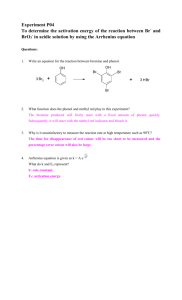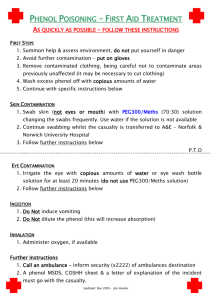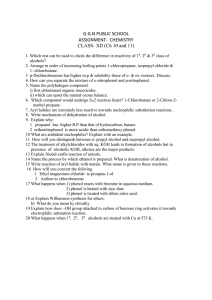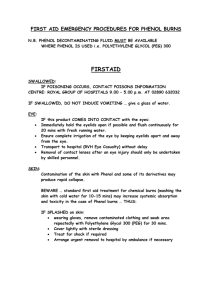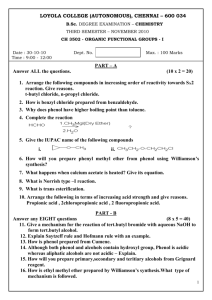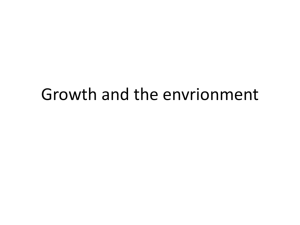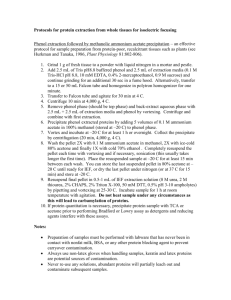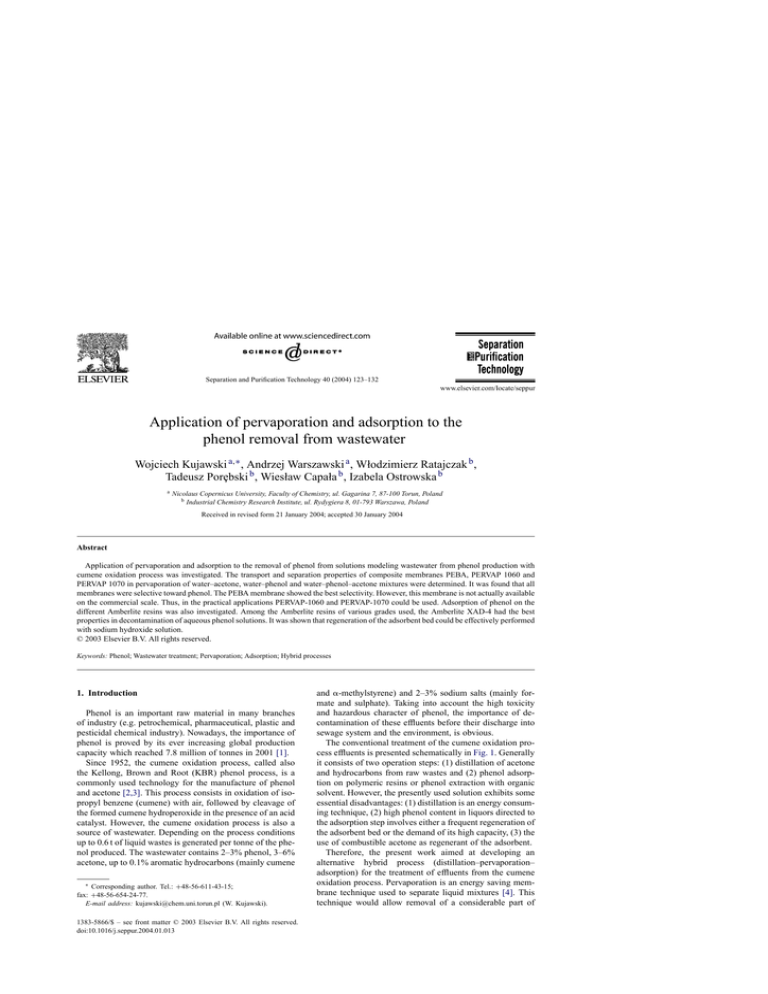
Separation and Purification Technology 40 (2004) 123–132
Application of pervaporation and adsorption to the
phenol removal from wastewater
Wojciech Kujawski a,∗ , Andrzej Warszawski a , Włodzimierz Ratajczak b ,
Tadeusz Porȩbski b , Wiesław Capała b , Izabela Ostrowska b
a
Nicolaus Copernicus University, Faculty of Chemistry, ul. Gagarina 7, 87-100 Torun, Poland
b Industrial Chemistry Research Institute, ul. Rydygiera 8, 01-793 Warszawa, Poland
Received in revised form 21 January 2004; accepted 30 January 2004
Abstract
Application of pervaporation and adsorption to the removal of phenol from solutions modeling wastewater from phenol production with
cumene oxidation process was investigated. The transport and separation properties of composite membranes PEBA, PERVAP 1060 and
PERVAP 1070 in pervaporation of water–acetone, water–phenol and water–phenol–acetone mixtures were determined. It was found that all
membranes were selective toward phenol. The PEBA membrane showed the best selectivity. However, this membrane is not actually available
on the commercial scale. Thus, in the practical applications PERVAP-1060 and PERVAP-1070 could be used. Adsorption of phenol on the
different Amberlite resins was also investigated. Among the Amberlite resins of various grades used, the Amberlite XAD-4 had the best
properties in decontamination of aqueous phenol solutions. It was shown that regeneration of the adsorbent bed could be effectively performed
with sodium hydroxide solution.
© 2003 Elsevier B.V. All rights reserved.
Keywords: Phenol; Wastewater treatment; Pervaporation; Adsorption; Hybrid processes
1. Introduction
Phenol is an important raw material in many branches
of industry (e.g. petrochemical, pharmaceutical, plastic and
pesticidal chemical industry). Nowadays, the importance of
phenol is proved by its ever increasing global production
capacity which reached 7.8 million of tonnes in 2001 [1].
Since 1952, the cumene oxidation process, called also
the Kellong, Brown and Root (KBR) phenol process, is a
commonly used technology for the manufacture of phenol
and acetone [2,3]. This process consists in oxidation of isopropyl benzene (cumene) with air, followed by cleavage of
the formed cumene hydroperoxide in the presence of an acid
catalyst. However, the cumene oxidation process is also a
source of wastewater. Depending on the process conditions
up to 0.6 t of liquid wastes is generated per tonne of the phenol produced. The wastewater contains 2–3% phenol, 3–6%
acetone, up to 0.1% aromatic hydrocarbons (mainly cumene
∗ Corresponding author. Tel.: +48-56-611-43-15;
fax: +48-56-654-24-77.
E-mail address: kujawski@chem.uni.torun.pl (W. Kujawski).
1383-5866/$ – see front matter © 2003 Elsevier B.V. All rights reserved.
doi:10.1016/j.seppur.2004.01.013
and ␣-methylstyrene) and 2–3% sodium salts (mainly formate and sulphate). Taking into account the high toxicity
and hazardous character of phenol, the importance of decontamination of these effluents before their discharge into
sewage system and the environment, is obvious.
The conventional treatment of the cumene oxidation process effluents is presented schematically in Fig. 1. Generally
it consists of two operation steps: (1) distillation of acetone
and hydrocarbons from raw wastes and (2) phenol adsorption on polymeric resins or phenol extraction with organic
solvent. However, the presently used solution exhibits some
essential disadvantages: (1) distillation is an energy consuming technique, (2) high phenol content in liquors directed to
the adsorption step involves either a frequent regeneration of
the adsorbent bed or the demand of its high capacity, (3) the
use of combustible acetone as regenerant of the adsorbent.
Therefore, the present work aimed at developing an
alternative hybrid process (distillation–pervaporation–
adsorption) for the treatment of effluents from the cumene
oxidation process. Pervaporation is an energy saving membrane technique used to separate liquid mixtures [4]. This
technique would allow removal of a considerable part of
124
W. Kujawski et al. / Separation and Purification Technology 40 (2004) 123–132
Nomenclature
List of symbols
BV
volume of resin bed
c
concentration [g dm−3 ]
Ji
permeate flux of species i [g m−2 h−1 ]
k, n coefficients of the Freundlich equation
q
adsorption capacity [g dm−3 ]
Greek letters
α
separation factor
β
enrichment factor
Fig. 2. Scheme of the laboratory scale pervaporation setup.
the organic pollutants, whereas adsorption, the classical
separation technique, would lower the phenol concentration
of the treated effluent to the level acceptable by wastewater
treatment plant. In the present paper, we describe the results
of our studies on the pervaporative removal of phenol using
different hydrophobic membranes and followed by phenol
adsorption on polymeric resins.
2. Experimental
2.1. Pervaporation experiments
Pervaporation experiments were carried out in the
laboratory-scale pervaporation system presented in Fig. 2
[5]. System was composed of a temperature controlled feed
vessel, circulating pump, membrane test cell, cold fingers
and vacuum pump. Feed solution was pump to a membrane
test cell with a membrane area equal to 170 cm2 . The pervaporation system was operated at 333 K (water–phenol mixture) and at 313 K (water–acetone, water–acetone–phenol
mixtures). During experiments the upstream pressure was
maintained at the atmospheric pressure, while the downstream pressure was kept below 1 mbar by using a vacuum
pump. Permeate was collected into cold fingers cooled by
liquid nitrogen. To avoid phenol condensation before the
cold traps, the permeation part of the pervaporation system
was heated to 333 K. Permeation fluxes were determined by
weighing permeate collected over a given period of time in
the cold fingers. Composition of both the feed and permeate mixtures was determined by using gas chromatography.
VARIAN 3300 gas chromatograph equipped with PORAPAC Q packed column and a thermal conductivity detector
(TCD) was used. JMBS BORWIN Software (Le Fontanil,
France) was used to the data acquisition and processing.
Samples were injected by the direct on-column injection
technique. Each sample was analyzed three times.
Performance properties of a given pervaporation membrane were defined by the separation factor ␣ (Eq. (1)) and
permeate fluxes J [4].
αorg/water =
(corg /cwater )permeate
(corg /cwater )feed
(1)
where corg and cwater denote the weight fraction of organic
and water component, respectively.
The experiments were carried out using composite membranes PERVAP-1060, PERVAP-1070 (Sulzer Chemtech
Membrane Systems A.G., Neunkirchen, Germany) and
PEBA (GKSS-Forschungszentrum Geesthacht GmbH,
Geesthacht, Germany). Characteristics of the investigated
membranes are listed in Table 1, and the composition
of investigated water–organic mixtures is presented in
Table 2.
Fig. 1. Scheme of the cumene process wastewaters treatment.
W. Kujawski et al. / Separation and Purification Technology 40 (2004) 123–132
125
Table 1
Characteristics of the investigated membranes, according to the manufacturers’ data
Membrane
Thickness of the
selective layer (m)
Composition of the selective layer
PDMSa
PERVAP-1060
8
PERVAP-1070
10
Zeoliteb filled PDMS
PEBA
80
PEBAc
a
b
c
PDMS–poly(dimethylsiloxane).
Zeolite ZSM-5: Nan [Aln Si(96−n) O192 ] ∼ 16 H2 O, n < 27.
Block copolymer polyether–polyamide (PE–PA).
Table 2
The composition of feed solutions
Mixture
Content of the organic
component (wt.%)
Temperature
(K)
Water–acetone
Water–phenol
water–acetone–phenol
0–8
0–7
0–8
313
333
313
2.2. Adsorption experiments
The Amberlite resins, XAD-4, XAD-7 and XAD-16, manufactured by Rohm and Hass Co. were applied in adsorption
experiments. The properties of the adsorbents are presented
in Table 3. Prior to use, all the adsorbent samples were standardized using the following procedure: the dry resin sample
(100 cm3 ) was placed in a column and the adsorbent bed was
rinsed using distilled water (500 cm3 ), acetone (200 cm3 )
and distilled water (1000 cm3 ) with the volumetric flow rate
200 cm3 h−1 .
Adsorption experiments under static conditions using
three Amberlite resins were carried out by the batch method
[6]. The samples of an adsorbent (0.6–25 g) were shaken
with 100 cm3 of aqueous phenol solution (10 g dm−3 ).
When adsorption reached equilibrium, phenol concentration in solution was determined. The amount of phenol in
adsorbent was calculated from concentrations of solution
before and after adsorption.
The column method [6] was applied to determine adsorption properties under dynamic conditions using the
Amberlite XAD-4 resin. The model feed solutions containing different amounts of phenol (i.e. 3 and 5 g dm−3 )
and sodium sulphate (30 g dm−3 ) were controlled to pass
through the resin bed with volumetric feed rate of 2 BV h−1 .
The symbol BV denotes the volume of resin bed. After
a breakthrough of the column the model solution was removed and resin was regenerated (proportioning rate of a
regenerant was 1 BV h−1 ). The following liquid mixtures
were used as regenerants: water, sodium sulphate solution
(30 g dm−3 ), treated model solution (phenol concentration:
0.08 g dm−3 ) and sodium hydroxide solution (200 g dm−3 ).
Phenol content in the investigated mixtures was determined by spectrophotometric analysis [7].
3. Results and discussion
3.1. Pervaporation
The pervaporation results for water–phenol, water–acetone and water–phenol–acetone mixtures were shown in
Figs. 3–12.
Table 3
Characteristics of the Amberlite resins
Copolymerisate
[m2 g−1 ]
Specific surface area
Porosity [cm3 cm−3 ]
Bulk density [g cm−3 ]
Particle size [mm]
XAD-4 styrene–divinylbenzene
XAD-7 acrylate–divinylbenzene
XAD-16 styrene–divinylbenzene
750
0.65–0.70
0.62–0.63
0.3–1.2
450
0.55
0.62
0.3–1.2
750
0.58–0.63
0.61
0.3–1.2
126
W. Kujawski et al. / Separation and Purification Technology 40 (2004) 123–132
Fig. 3. Separation diagram of hydrophobic membranes investigated in
contact with binary water–acetone mixtures (T = 313 K, permeate pressure <1 mbar).
All investigated hydrophobic membranes were selective
toward the organic component of the mixture, however, the
selectivity was dependent on both the polarity of organic
component and the kind of the membranes used for the
separation.
In case of water–acetone mixture (Fig. 3) the best separation properties were found for PERVAP-1070 membrane,
i.e. the PDMS membrane with zeolite filling, whereas the
PEBA membrane exhibited the lowest selectivity. During the
treatment of wastewater from the cumene oxidation process,
acetone is removed by distillation and its content is usually
low (Fig. 1). The content of acetone could be further diminished by pervaporation.
Fig. 4. Separation diagram of hydrophobic membranes investigated in
contact with binary water–phenol mixtures (T = 333 K, permeate pressure
<1 mbar).
Fig. 5. Enrichment β factor of hydrophobic membranes investigated in
contact with binary water–phenol mixtures (T = 333 K, permeate pressure
<1 mbar).
In contact with aqueous phenol solutions, the PEBA membrane, made of poly(ether block amide) polymer, showed the
highest selectivity. Both PDMS membranes were less selective (Figs. 4 and 5). The high selectivity of PEBA membranes
in contact with water–phenol mixtures have been already
reported by Kondo et al. [8] and Boeddeker et al. [9]. The
enrichment factor β (i.e. a ratio of mass fractions of the component preferentially transported in permeate and in feed,
respectively) [4] found for the PEBA membrane (Fig. 5) was
in the same range as found by Boeddeker et al. [9].
It is worth noting that for both the binary systems investigated, the zeolite filling of PERVAP-1070 membrane improved the membrane selectivity (Figs. 3–5).
Fig. 6. Separation diagram of hydrophobic membranes investigated in
contact with ternary water–phenol–acetone mixtures (T = 313 K, permeate
pressure <1 mbar).
W. Kujawski et al. / Separation and Purification Technology 40 (2004) 123–132
Fig. 7. Permeate phenol flux through hydrophobic membranes investigated
in contact with binary water–phenol mixtures (T = 333 K, permeate
pressure <1 mbar).
127
Fig. 9. Permeate phenol flux through hydrophobic membranes investigated in contact with ternary water–phenol–acetone mixtures (T = 313 K,
permeate pressure <1 mbar).
The selectivity of investigated membranes in contact with
water–phenol–acetone ternary mixture (Fig. 6) showed the
similar trends as for water–phenol binary mixture (Fig. 4).
The selectivity of membrane in contact with a ternary mixture is usually lower than that in contact with a binary one
[10]. This is caused by the additional plasticization effect exerted by the other organic component on the polymeric matrix, resulting in the increase of the water diffusion through
the membrane. The separation coefficients α (Eq. (1)) presented in Table 4 indicated that selectivity of the investigated
membranes decreased with increase of the phenol content
in the feed [7,8].
The transport properties of the investigated membranes
in contact with water–acetone, water–phenol and water–
phenol–acetone mixtures were presented in Figs. 7–12.
The permeate flux of the organic component (i.e. phenol
and/or acetone) through the membranes was linearly dependent on the feed composition (Figs. 7,9 and 11). The
highest flux of phenol through the PEBA membrane in
contact with 2 wt.% phenol solution was 150 g m−2 h−1
(Fig. 9). The permeate flux of water was also substantial (around 200 g m−2 h−1 for PEBA and PERVAP-1070
membranes and 600–800 g m−2 h−1 for the PERVAP-1060
membrane) but practically independent on the feed composition (Figs. 8,10 and 12). The detailed comparison
of fluxes of water and organics molecules through both
PERVAP-1060 (i.e. PDMS membrane) and PERVAP-1070
(i.e. zeolite filled PDMS membrane) allowed the expla-
Fig. 8. Permeate water flux through hydrophobic membranes investigated
in contact with binary water–phenol mixtures (T = 333 K, permeate
pressure <1 mbar).
Fig. 10. Permeate water flux through hydrophobic membranes investigated in contact with ternary water–phenol–acetone mixtures (T = 313 K,
permeate pressure <1 mbar).
128
W. Kujawski et al. / Separation and Purification Technology 40 (2004) 123–132
Fig. 11. Permeate acetone flux through PDMS (PERVAP-1060) and zeolite
filled PDMS (PERVAP-1070) hydrophobic membranes in contact with
binary water–acetone mixtures (T = 313 K, permeate pressure <1 mbar).
Fig. 12. Permeate water flux through PDMS (PERVAP-1060) and zeolite
filled PDMS (PERVAP-1070) hydrophobic membranes in contact with
binary water–acetone mixtures (T = 313 K, permeate pressure <1 mbar).
nation of the role of zeolite filling in the separation of
water–acetone and water–phenol mixtures (Figs. 7,8,11
and 12). It can be seen that for both the mixtures the selectivity of the PERVAP-1070 membrane exceeded that
Fig. 13. Phenol content in retentate vs. duration of batch pervaporation
process with hydrophobic membranes investigated (V/S = 2.5).
of the PERVAP-1060 one. In general, a decrease of water
flux would be expected due to the increase in the diffusion pathway in the polymer matrix in the presence of the
hydrophobic zeolite particles. On the other hand, the flux
of organic component can increase or decrease, depending
on the balance between the loss in flux due to the increase
of a tortuosity pathway and augmentation of organic compound sorption in the zeolite particles [5]. In the case of
water–acetone, zeolite fillings caused the decrease of both
water and acetone fluxes (Figs. 11 and 12), but the lowering
of water flux was more pronounced. On the other hand, in
the case of water–phenol mixture, zeolite fillings caused
the substantial decrease of the water flux only (Fig. 8),
whereas the flux of phenol remained practically unaltered
(Fig. 7).
There are several papers dealing with the feasibility of
pervaporation process to recover phenol from wastewater
[8,11–13]. Usually, pervaporation was combined with another technique (both the classical or membrane one) into
a hybrid process. The most work was done with the systems with phenol content in the feed in the range of hundred parts per million. One must remember, however, that
the concentration polarization effects are very strong at this
concentration region, which results in the decreasing of the
Table 4
Selectivity of hydrophobic membranes in contact with binary and ternary water–organics systems
Feed composition
(wt.% phenol)
PEBAX 4033
␣a H2 O/PhOH/Ac
␣b H2 O/PhOH
␣a H2 O/PhOH/Ac
␣b H2 O/PhOH
␣a H2 O/PhOH/Ac
␣b H2 O/PhOH
1
2
4
33.0
22.0
13.5
42.4
41.7
39.0
5.5
5.1
4.5
14.0
13.6
12.3
1.4
1.4
1.3
4.1
3.9
3.5
PhOH: phenol, Ac: acetone.
a Water–phenol–acetone system, T = 313 K.
b Water–phenol system, T = 333 K.
PERVAP 1070
PERVAP 1060
W. Kujawski et al. / Separation and Purification Technology 40 (2004) 123–132
129
Table 5
Efficiency of the phenol removal from wastewater, by using batch pervaporation with different hydrophobic membranes
Membrane
Time of pervaporation (h)
Retentate
Permeate
Fraction of feed
Phenol content (wt.%)
Fraction of feed
Phenol content (wt.%)
PERVAP-1070
PERVAP-1060
PEBA
27
18
8
0.80
0.43
0.92
0.18
0.17
0.17
0.20
0.57
0.08
14.0
5.1
35.2
V/S: 25 kg m−2 , T: 333 K, feed: 3 wt.% of phenol.
efficiency of the process. Application of adsorption would
be much more efficient in this concentration range.
The results obtained on the transport and selective properties of membranes investigated in this work were applied
to the estimation of the efficiency of pervaporation in the
removal of phenol from wastewater. Assuming that the feed
concentration of phenol was equal to 30 g dm−3 (Fig. 1), we
estimated, for each membrane, the time needed to lower the
content of phenol in retentate, down to 2 g dm−3 (Fig. 13).
Additionally, the amount and composition of permeate were
also calculated (Table 5). Calculations were made for the
batch pervaporation and the feed to the membrane area ratio
(V/S) equal to 25 kg m−2 .
Present results proved the high efficiency of the PEBA
membrane in the recovery of phenol. The pervaporation unit
with the PEBA membrane would need about 8 h to decrease
the phenol level in the retentate down to 2 g dm−3 . Moreover,
permeate was only 8% of the beginning amount of the feed
mixture, with the average content of phenol equal to 35 wt.%.
Thus, the phenol content in the treated wastes would be diminished about 15 times. Calculations made for the both
PDMS membranes (i.e. PERVAP-1060 and PERVAP-1070)
showed that time needed for the wastewater treatment would
be longer (Table 5). It is also worth mentioning that time
needed to reach a given dephenolization degree, can be altered by changing the temperature of the system and by
changing the V/S ratio (Fig. 14) [10].
More results on the optimization of the pervaporation process for the phenol recovery from wastewater, based on pervaporation experiments in a larger scale, have been recently
performed in our laboratory [14].
Fig. 14. Phenol content in retentate vs. duration of batch pervaporation
process using PEBA membrane for different V/S ratio.
also the earlier results obtained by Li et al. for sorption of
phenol traces by Amberlite XAD-4 (phenol concentration
below 1 g dm−3 ) [20,21]. Additional experiments, which
were carried out for ternary solutions containing various
amounts of sodium sulphate (up to 50 g dm−3 ) indicated
that phenol sorption on the Amberlite XAD-4 increased
with the increase of Na2 SO4 content in solution (Table 6).
Adsorption equilibria are usually described using various
equations. Among them the Freundlich and the Langmuir
equations are the most frequently used [16,19–21]. In the
case of the investigated Amberlite resins the best fitting was
3.2. Adsorption
3.2.1. Equilibrium adsorption
Sorption isotherms of phenol on the Amberlite resins
(XAD series) plotted in Fig. 15 enabled the comparison of properties of various adsorbents and the choice
of the most efficient one. The Amberlite XAD-4 and
XAD-16 resins made of styrene–divinylbenzene copolymer
showed higher affinity to phenol than the XAD-7 one with
methyl acrylate–divinylbenzene copolymer matrix. The
poly(styrene–divinylbenzene) resins were known as efficient
phenol adsorbent [15]. Amberlite XAD-4 was successively
used for adsorption of various organic compounds [16,17],
among them aromatic ones [18,19]. Our results confirmed
Fig. 15. Adsorption isotherms of phenol on the Amberlite resin of various
grades. Experimental points were indicated, curves correspond to the
Freundlich equation.
130
W. Kujawski et al. / Separation and Purification Technology 40 (2004) 123–132
Table 6
Coefficients of the Freundlich equation for the adsorption of phenol on
the Amberlite resin of various grades
adsorbent
Na2 SO4 content
(g dm−3 )
k
n
r
XAD-7
XAD-16
XAD-4
XAD-4
XAD-4
0
0
0
20
50
16.12
22.47
31.81
34.37
36.97
2.268
2.247
2.326
2.381
2.564
0.9920
0.9999
0.9981
0.9997
0.9994
obtained using the former one. The coefficients k and n of
the Freundlich equation:
q = kc1/n
(2)
where q is adsorption capacity (mass of phenol per unit volume of adsorbent), c the equilibrium phenol concentration in
solution, were listed in Table 6. In all cases, the Freundlich
equation fitted well the experimental data (correlation coefficients r over 0.99). The coefficient k was usually considered as a relative indicator of adsorption capacity. The concave shape of the isotherms and the coefficient n exceeding
unity indicated favourable phenol adsorption [21].
Taking into account the results concerning equilibrium
phenol adsorption on various grades of the Amberlite resin,
further adsorption experiments under dynamic conditions
were carried out using Amberlite XAD-4 alone.
3.2.2. Adsorption under dynamic conditions
Adsorption under dynamic conditions was performed in
order to investigate properties of the chosen adsorbent Amberlite XAD-4 during adsorption and regeneration steps. The
solutions modelling partially dephenolized wastes contained
phenol (3–5 g dm−3 ) and sodium sulphate (30 g dm−3 ). Four
kinds of incombustible liquors were used to regenerate the
resin bed.
The breakthrough curve for the adsorption step made it
possible to estimate the volume of eluate up to breakthrough
point (Vs ), which corresponded to the volume of decontaminated eluate. On the other hand, the regeneration (elution)
curve indicated the volume of a regenerant (VR ) at which
its concentration decreased to a desired low value. This volume of regenerant was necessary to elute phenol out from
the bed resin. The difference V = Vs − VR was regarded
as a measure of the efficiency of the regenerant used. The
higher V value, the more efficient the regenerant was.
The breakthrough and regeneration curves obtained
at 368 K (95 ◦ C) using water, sodium sulfate solution
(30 g dm−3 ) and treated model solution (with phenol concentration of 0.08 g dm−3 ) were presented in Fig. 16. Phenol concentration in the feed was equal to 5 g dm−3 . It was
found that the highest volume of the treated waste (V
≈ 6 BV) was obtained, when the adsorbent bed was regenerated with hot water. Sodium sulfate solution and treated
model solution were the less efficient regenerants (V
approximately equal to 4 and 1 BV, respectively).
Fig. 16. The breakthrough curve for adsorption and the regeneration
(elution) curve. The Amberlite XAD-4 bed regenerated at 368 K using
water, sodium sulphate solution and treated model solution. The dashed
line indicates phenol concentration in the feed (5 g dm−3 ). The eluate
volume on the abscissa axis is expressed in the volume of resin bed (BV).
Fig. 17. The breakthrough curve for adsorption and the regeneration
(elution) curve. The Amberlite XAD-4 bed regenerated at 333 K using
sodium hydroxide solution (200 g dm−3 ). The dashed line indicates phenol
concentration in the feed (3 g dm−3 ). The eluate volume on the abscissa
axis is expressed in the volume of resin bed (BV).
The regeneration step could be carried out efficiently
with hydroxide solution due to the chemical reaction between phenol and hydroxide. The phenolate formed is not
adsorbed on the resin and as the consequence the low
concentration of phenol in solution changes the equilibrium sorption–desorption enhancing desorption of phenol
from the bed. It is seen from Fig. 17, that about 8 BV
of the model waste solution (i.e. solution containing phenol at the concentration 3 g dm−3 ) could be purified in
one adsorption-regeneration cycle. Moreover, it would be
possible to use sodium hydroxide solution (200 g dm−3 )
several times as an efficient regenerant, which could additionally decrease the total volume of the concentrate. The
breakthrough curves proved also that the repeated usage of
sodium hydroxide solution did not influence the efficiency
of the adsorption of phenol during the next adsorption steps
(Fig. 17).
4. Conclusions
Pervaporation experiments proved that phenol could
be effectively removed from the aqueous solutions using
the appropriate organophilic membranes. All investigated
membranes (i.e. PERVAP-1060, PERVAP-1070 and PEBA)
W. Kujawski et al. / Separation and Purification Technology 40 (2004) 123–132
131
Fig. 18. The proposed hybrid pervaporation–adsorption process for treatment of wastewaters containing phenol. (A) General concept. (B) Pervaporation
part of the hybrid system [14].
showed interesting selective and transport properties in
contact with binary and ternary water–organics mixtures.
In general, the membrane selectivity was smaller in contact
with ternary mixture comparing to the binary one. Although
the poly(ether block amide) membrane (PEBA) possessed
the best separation properties in the removal of phenol, it is
not actually available on the commercial scale. Thus, in the
practical applications PERVAP-1060 and PERVAP-1070
could be used [14]. Partial permeate fluxes of phenol
through both PDMS membranes were practically the same.
It means that the presence of zeolite filling of PERVAP-1070
membrane did not influence the phenol transport. On the
other hand, flux of water was much smaller through the
PDMS membrane with the zeolite filling (PERVAP-1070)
compared to the pure PDMS membrane (PERVAP-1060).
The enhancement of transport in the presence of zeolite
was observed in the case of acetone transport.
The static adsorption experiments proved that the Freundlich equation described well the sorption phenomena in
all systems. The best sorption properties were found in the
case of the Amberlite XAD-4. Using this adsorbent, made
of cross-linked styrene–divinylbenzene copolymer, the removal of phenol from model solution containing phenol
(3–0 g dm−3 ) and sodium sulphate (30 g dm−3 ) was carried
out by the column method. Non-combustible liquors: distilled water, sodium sulphate solution (30 g dm−3 ), eluate
and sodium hydroxide solution (200 g dm−3 ) were used to
regenerate the sorbent bed. The breakthrough curve and the
regeneration (elution) curve were determined. It was found
that the regeneration of the sorbent bed using NaOH solution enables the most effective removal of phenol from low
concentrated solution.
Pervaporation and adsorption results obtained with
water–phenol mixtures suggest that the hybrid system could
be used to the efficient decontamination of the effluents
from the cumene oxidation process. The scheme of such
hybrid process was presented in Fig. 18 [14].
References
[1] Anonymus, Phenol, Chem. Week 164 (2002) 31.
[2] P. Wiseman, An Introduction to Industrial Organic Chemistry, Applied Science Publishers Ltd., London, 1979.
[3] W. Jordan, H. van Barneveld, O. Gerlich, M. Kleine-Boymann, J.
Ullrich, Phenol, in: B. Elves, S. Hawkins, W. Russey, G. Schulz
(Eds.), Ullmanns Encyclopaedia of Industrial Chemistry, vol. A19,
VCH Publishers, Weinheim, 1991, pp. 299–312.
[4] W. Kujawski, Polish J. Environ. Stud. 9 (2000) 13.
[5] W. Kujawski, Sep. Sci. Technol. 35 (2000) 89.
[6] M. Marhol, Ion Exchangers in Analytical Chemistry. Their Properties
and Use in Inorganic Chemistry, Academia, Prague, 1982.
[7] T. Nowicka-Jankowska, E. Wieteska, K. Gorczyñska, A. Michalik, Spektro-fotometria UV/VIS w Analizie Chemicznej, PWN,
Warszawa, 1988.
[8] M. Kondo, H. Sato, Desalination 98 (1994) 147.
[9] K.W. Boeddeker, G. Bengston, E. Bode, J. Membr. Sci. 53 (1990)
143.
[10] W. Kujawski, R. Roszak, Sep. Sci. Technol. 37 (2002) 3559.
[11] C.C. Pereira, A.C. Habert, R. Nobrega, C.P. Borges, J. Membr. Sci.
138 (1998) 227.
[12] M. Benett, B.J. Bridson, R. England, R.W. Field, J. Membr. Sci. 137
(1997) 63.
[13] P. Wu, R.W. Field, R. England, B.J. Bridson, J. Membr. Sci. 190
(2001) 147.
[14] W. Kujawski, A.Warszawski, W.Capała, R.Ratajczak, Application of
pervaporation to treatment of wastewater containing phenol, Przem.
Chem. 83 (2004), in press.
132
W. Kujawski et al. / Separation and Purification Technology 40 (2004) 123–132
[15] C. Klampfl, E. Spanos, J. Chromatogr. A 715 (1995) 213.
[16] D.S. Grzegorczyk, G. Carta, Chem. Eng. Sci. 51 (1996) 807.
[17] J.L. Martı́nez Vidal, F.J. Egea González, C.R. Glass, M. Martı́nez
Galera, M.L. Castro Cano, J. Chromatogr. A 765 (1997) 99.
[18] W.-L. Song, Z.-L. Zhi, L.-S. Wang, Talanta 44 (1997) 1423–
1433.
[19] Z. Xu, Q. Zhang, J. Chen, L. Wang, G.K. Anderson, Chemosphere
38 (1999) 2003–2011.
[20] A. Li, Q. Zhang, J. Chen, Z. Fei, C. Long, W. Li, React. Funct.
Polym. 49 (2001) 225–233.
[21] A. Li, Q. Zhang, G. Zhang, J. Chen, Z. Fei, F. Liu, Chemosphere
47 (2002) 981–989.

